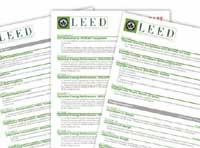Going ‘Green’ Pays Off
Going ‘Green’ Pays Off
Sustainable design certification benefits people, the environment, and the bottom line
| |
| The Poudre School District’s new high school in Fort Collins, CO, will be LEED-certified, utilizing a super-insulated building envelope with high-efficiency glass, daylighting, photoelectric eyes, a high-efficiency condensing boiler, and air-to-air heat enchangers. Designed by RB+B Architects, Inc., and MKK Consulting Engineers, Inc., the 294,000-sq.-ft. building is scheduled for completion in fall 2004.
|
 |
| The LEED Green Building Rating System Version 2.1 provides a national standard delineating the design,construction, and operational requirements for green buildings. |
More and more municipalities and government agencies are demanding “green” buildings. In this case, green refers to meaningful strategies for sustainable facility design that encompass all phases of building design, construction, operation, and maintenance.
In an effort to reduce long-term facility costs and to become more environmentally conscious, the General Services Administration (GSA) has mandated that new and remodeled buildings meet a minimum level of sustainable design certification. To this end, the GSA has adopted the LEED (Leadership in Energy and Environ-mental Design) certification system created by the U.S. Green Building Council (USGBC) to assess building performance and adherence to sustainable design goals. The LEED Green Building Rating System Version 2.1 provides a national standard delineating the design and construction requirements for a green building. Using the rating system as a design guideline and certification tool, LEED certification “…aims to improve occupant well-being, environmental performance, and economic returns of buildings using established and innovative practices, standards, and technologies.”
Understanding the LEED certification ratings and how to achieve facility certification with design, construction, and operational credits based on the system has become imperative as government agencies look for ways to become more environmentally friendly, conserve energy, and decrease the operating costs of their real estate.
To construct a truly sustainable building environment requires moving beyond the “firstcost/lowest-cost” perspective and beginning to account for long-term, life-cycle building expenditures. The design team must be able to determine the building’s real cost, which will include not only the amount spent to construct the facility but also the ongoing expenses required for building operations and maintenance. These ongoing expenses account for 60 to 85 percent of a build-ing’s actual capital expenditures, says the National Research Council, and provide the key to a sustainable design. The following facility design considerations potentially hold the greatest impact for reducing long-term building costs.
Site Selection and Configuration
Becoming a steward of the environment starts, in many instances, by avoiding prime, undeveloped land for a new building location and, instead, choosing a brownfield or other mitigating site for the new construction project. The LEED rating system emphasizes the use of urban infill sites in order to maximize existing urban transportation corridors and protect and maintain precious open space, wetlands, and agricultural assets.
Once a site has been selected, the marriage of the building to the site is another key component in achieving LEED certification. Minimizing site disturbance while emphasizing water-efficient, attractive landscapes, designing facilities to
maximize solar orientation and provide natural daylight, and articulating the building envelope to mitigate the natural environment all contribute significantly toward achieving the required level of facility certification.
Water Efficiency
Water conservation is a strong consideration in the LEED rating and certification system. Planning and design for water conservation should include all aspects of water usage from landscaping to water-use reduction and recycling. Some of the most innovative ways to reduce water consumption start with specifying low-consumption fixtures for toilets and showerheads, electronic controls for lavatory faucets, and high-efficiency irrigation systems. These simple measures can reduce water usage by as much as 20 to 30 percent. More advanced measures involve recycling grey water for non-potable uses and storage and reuse of rainwater for site irrigation.
Energy
The amount of energy a building requires for normal, daily operations over its lifetime accounts for a large portion of the actual facility cost. Designing building components to reduce energy consumption while still providing a safe and productive work environment is mandatory in the LEED rating system. Thoughtful, integrated design of building HVAC, lighting, and power systems is required to meet LEED goals.
High-efficiency lighting systems are more costly at the outset but can save as much as 15 percent of typical lighting costs over the building’s life. This is achieved by occupancy sensors that automatically shut off light fixtures when a space is not occupied, photocells that automatically dim the lights in response to the amount of natural light entering the building, and incorporation of daylighting concepts into the building’s design.
Modern HVAC systems should be designed with high-efficiency motors that maximize the heating and cooling of an entire facility with reduced cost to the building’s overall operations. Based on an integrated design approach and proper installation, these systems create more comfortable work environments and are able to perform within facility budgets with few, if any, problems.
There are a number of options for alternative power sources that are accredited by the LEED system. One of these sources is wind power, and many energy providers offer easy access to this power source. Using alternative sources of energy such as wind, solar, geothermal, and photovoltaics can reduce typical building energy consumption by as much as 60 percent.
Indoor Environmental Quality
In terms of building efficiency and long-term cost effectiveness, the LEED system places heavy emphasis on the indoor environmental quality of a building. So-called “sick” buildings, which often are the result of mold, mildew, and poor indoor air quality, can greatly impact employee productivity and turnover rates. Since few insurance companies protect against these building design and construction deficiencies, facility owners and managers must address these issues within the design and construction processes. Simple measures can be employed to specify materials that do not contain VOCs (Volatile Organic Compounds often found in paint, furniture, and carpet); to design HVAC systems that minimize cross-contamination of air-distribution systems between copy rooms, chemical labs, or other volatile spaces and occupied areas; and by planning for and constructing a healthier work environment.
Materials
The LEED rating system also examines the specific types of materials used for overall facility design. The design and construction team is required to identify materials that are low in VOCs and chlorofluorocarbons (CFCs), have mandated percentages of recycled content, and are manufactured within a reasonably limited radius of the project site to reduce the embodied energy of the materials and, thus, their environmental impact. Other considerations, such as the simple storage and collection of materials for recycling, prudent construction waste-management practices, and adaptive building reuse (maintaining a certain percentage of an existing building structure and shell) also contribute to achieving LEED goals for sustainable design.
With billions of square feet of real estate owned and managed by the GSA, the LEED rating system is taking on increased importance and will affect every government agency. Fortunately, more architectural and engineering firms across the nation are taking steps to understand the LEED rating and certification system, to incorporate these integrated-design approaches in their design philosophies, and to obtain the professional certification required, providing the necessary planning and design services to ensure new government buildings are LEED certified. With their knowledge and training in place, and combined with LEED guidelines, government agencies can take the necessary steps to design and build green buildings.
Editor’s Note:
Derek McPherren, PE, is a licensed Mechanical Engineer with MKK Consulting Engineers, Inc., and has participated on a number of LEED-certified projects. Anthony Serres, LC, is an Electrical Engineer with MKK Consulting Engineers, Inc., and is an LEED-accredited professional. Tom Watson, AIA, is a registered Architect in Colorado and has extensive training in the principles of sustainable design and LEED programs.
For more information about green buildings and the LEED certification system, visit www.usgbc.org

















